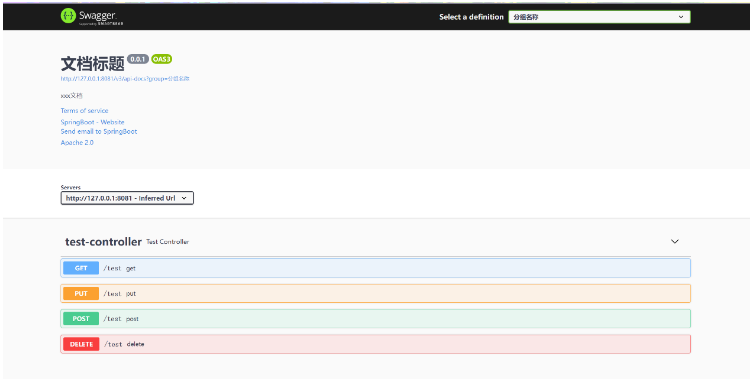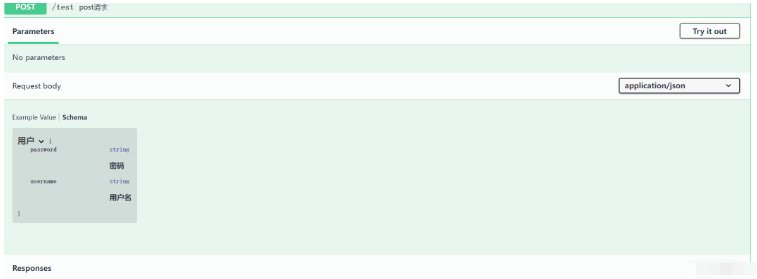Home >Java >javaTutorial >How springboot integrates swagger3 and knife4j
How springboot integrates swagger3 and knife4j
- 王林forward
- 2023-05-19 12:49:062212browse
springboot integrates swagger3
swagger3’s springboot starter jar package
<!-- https://mvnrepository.com/artifact/io.springfox/springfox-boot-starter -->
<dependency>
<groupId>io.springfox</groupId>
<artifactId>springfox-boot-starter</artifactId>
<version>3.0.0</version>
</dependency>Note: The current SpringBoot version is 2.5.6, and Swagger3.0 is currently not fully compatible with SpringBoot2.6. x!
Write TestController code
@RestController
@RequestMapping("test")
public class TestController {
@GetMapping
public Map<String, Object> get(@RequestParam String id) {
Map<String, Object> r = new HashMap<>(1);
r.put("id", id);
return r;
}
@PostMapping
public Map<String, Object> post() {
Map<String, Object> r = new HashMap<>(1);
r.put("code", 200);
return r;
}
@PutMapping
public Map<String, Object> put(String id) {
Map<String, Object> r = new HashMap<>(1);
r.put("id", id);
return r;
}
@DeleteMapping
public Map<String, Object> delete(String id) {
Map<String, Object> r = new HashMap<>(1);
r.put("id", id);
return r;
}
}Create Swagger3Configuration
@Configuration
@EnableOpenApi
public class SwaggerConfig {
private static final String VERSION = "0.0.1";
@Bean
public Docket createRestApi() {
return new Docket(DocumentationType.OAS_30)
.groupName("分组名称")
.apiInfo(apiInfo())
.select()
//要扫描的包
.apis(RequestHandlerSelectors.basePackage("com.example.swagger.controller"))
.paths(PathSelectors.any())
.build();
}
private ApiInfo apiInfo() {
return new ApiInfoBuilder()
// 设置标题
.title("文档标题")
//联系人
.contact(contact())
//描述
.description("xxx文档")
//服务
.termsOfServiceUrl("https://spring.io/")
//许可证
.license("Apache 2.0")
.licenseUrl("https://www.apache.org/licenses/LICENSE-2.0")
.version(VERSION)
.build();
}
private Contact contact (){
return new Contact("SpringBoot", "https://spring.io/", "email");
}
}Annotate the interface
Commonly used annotations in swagger
| Annotation | Function | Use location |
|---|---|---|
| Indicates the description of the class. Common parameters | Class | |
| Describes the purpose of the method | Method | |
| It can contain multiple @ApiImplicitParam | Method | |
| Description Purpose of parameters | Method | |
| Represents information of a data class | Class | |
| Describe the properties of the data class | Properties | |
| Ignore a field so that It is not displayed in the document | Attribute |
@ApiModel("用户")
@Data
public class User {
@ApiModelProperty("用户名")
private String username;
@ApiModelProperty("密码")
private String password;
}2. Add annotations to TestController @Api(tags = "测试接口")
@RestController
@RequestMapping("test")
public class TestController {
@ApiOperation("get请求")
@GetMapping
@ApiImplicitParam(name = "id", value = "测试用id", dataTypeClass = String.class)
public Map<String, Object> get(@RequestParam String id) {
Map<String, Object> r = new HashMap<>(1);
r.put("id", id);
return r;
}
@ApiOperation("post请求")
@PostMapping
public Map<String, Object> post(@RequestBody User user) {
Map<String, Object> r = new HashMap<>(1);
r.put("code", 200);
return r;
}
@ApiOperation("put请求")
@PutMapping
@ApiImplicitParam(name = "id", value = "put请求id", dataTypeClass = String.class)
public Map<String, Object> put(String id) {
Map<String, Object> r = new HashMap<>(1);
r.put("id", id);
return r;
}
@ApiOperation("delete请求")
@DeleteMapping
@ApiImplicitParam(name = "id", value = "delete请求id", dataTypeClass = String.class)
public Map<String, Object> delete(String id) {
Map<String, Object> r = new HashMap<>(1);
r.put("id", id);
return r;
}
}Running results


 ##Integration Better UI-knife4j
##Integration Better UI-knife4j
maven
<dependency> <groupId>com.github.xiaoymin</groupId> <artifactId>knife4j-micro-spring-boot-starter</artifactId> <version>3.0.3</version> </dependency>
Enabler
Add **@EnableKnife4j**
@Configuration @EnableOpenApi @EnableKnife4j public class SwaggerConfigon SwaggerConfig class
The above is the detailed content of How springboot integrates swagger3 and knife4j. For more information, please follow other related articles on the PHP Chinese website!
Statement:
This article is reproduced at:yisu.com. If there is any infringement, please contact admin@php.cn delete
Previous article:What are the situations that cause deadlock in Java?Next article:What are the situations that cause deadlock in Java?

